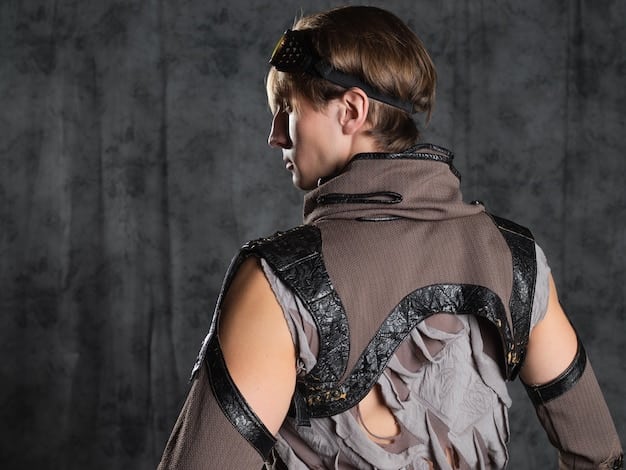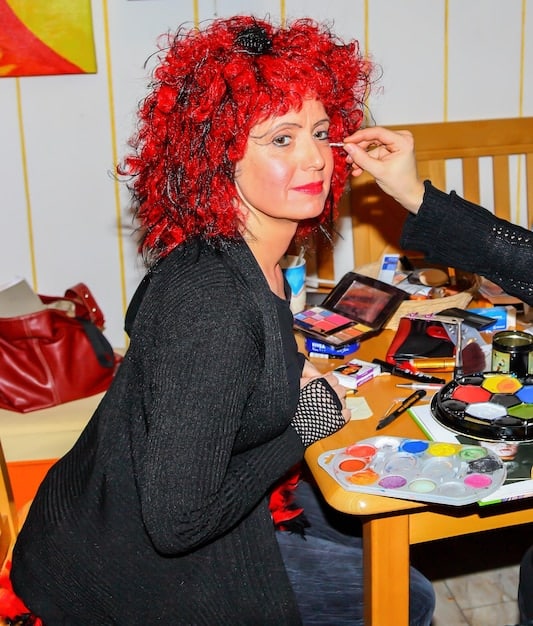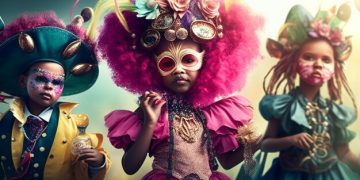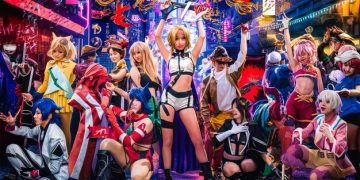The Ultimate Guide to Cosplay: Embrace Your Inner Geek

Cosplay, short for “costume play,” involves dressing up as characters from various fictional sources, requiring creativity, craftsmanship, and dedication to accurately portray beloved icons.
Are you ready to transform into your favorite character? Cosplay is more than just dressing up; it’s an art form that allows you to express your creativity and passion for geek culture.
What is Cosplay?
Cosplay, a portmanteau of “costume play,” is the performance art of dressing up as characters from anime, manga, video games, comic books, and other forms of media. It is a vibrant and expressive hobby that combines elements of costume design, acting, and fandom.
Cosplay allows individuals to embody their favorite characters, showcasing their creativity and craftsmanship. It is a way to connect with other fans and celebrate the stories and characters that inspire them.
The Origins of Cosplay
The roots of cosplay can be traced back to the science fiction fandom of the late 1930s in the United States, with enthusiasts dressing up for conventions. But modern cosplay, as we know it, truly took shape in Japan during the 1970s and 1980s.
Japanese fans, inspired by anime and manga, began creating increasingly elaborate costumes and performing as their favorite characters at conventions. This practice quickly gained popularity and spread globally, evolving into the diverse and passionate community we see today.
Key Elements of Cosplay
Cosplay involves several key elements, including costume design, character portrayal, and community engagement. Each of these aspects contributes to the unique and rewarding experience of cosplay.
- Costume Design: Creating or sourcing accurate and detailed costumes, including sewing, crafting props, and styling wigs.
- Character Portrayal: Embodying the personality, mannerisms, and iconic poses of the chosen character.
- Community Engagement: Attending conventions, participating in photoshoots, and connecting with other cosplayers.
Cosplay is a dynamic and evolving hobby where passion, creativity, and community intertwine. It provides a welcoming space for fans to express themselves and celebrate the stories they love.

Getting Started with Cosplay
Embarking on your cosplay journey can seem daunting, but with careful planning and a bit of creativity, anyone can create amazing costumes. Start by choosing a character you love and feel connected to.
Consider your skill level and available resources when selecting a character. Simple costumes can be just as impressive as complex ones, especially when executed with precision and passion.
Choosing Your First Character
Selecting the right character is crucial for a successful and enjoyable cosplay experience. Think about characters whose personalities resonate with you or whose designs you find particularly appealing.
Also, consider the complexity of the costume. For beginners, it’s best to start with simpler designs that don’t require advanced sewing or crafting skills.
Basic Materials and Tools
Depending on the complexity of your costume, you’ll need a variety of materials and tools. Start by gathering the essentials and gradually expand your collection as you gain experience.
- Fabric: Choose fabrics that match the texture and appearance of your character’s clothing.
- Sewing Machine: A basic sewing machine can greatly simplify the process of creating your costume.
- Craft Foam: Versatile and easy to work with, craft foam is perfect for creating armor and props.
- Wig: A well-styled wig is essential for accurately portraying many characters.
With the right tools and materials, you can bring your favorite characters to life. Remember to be patient and persistent as you learn new techniques and refine your skills.
Mastering Cosplay Makeup and Wigs
Makeup and wigs are essential components of a successful cosplay. They can dramatically alter your appearance and bring you closer to embodying your chosen character. Experiment with different techniques to find what works best for you.
Proper makeup application and wig styling can enhance your costume and make your character truly come to life. Don’t be afraid to try new things and learn from experienced cosplayers.
Techniques in Cosplay Makeup
Cosplay makeup involves a range of techniques to transform your features and accurately portray your character. Start with a clean canvas and use high-quality products to achieve the best results.
Contouring can help reshape your face, while strategic use of color can enhance your eyes and lips. Remember to research your character thoroughly and pay attention to their unique features.
Wig Styling Tips and Tricks
Styling a wig can be challenging, but with the right tools and techniques, you can create amazing hairstyles. Start by choosing a wig that closely matches your character’s hair color and style.
- Wig Cap: Always wear a wig cap to keep your natural hair in place and create a smooth base for the wig.
- Heat Tools: Use heat-safe wigs and styling tools to curl, straighten, or add volume to your wig.
- Hairspray: Hairspray is essential for holding your wig in place and preventing flyaways.
Experiment with different wig styling techniques to achieve the perfect look for your character. With practice, you’ll be able to create impressive and realistic hairstyles for your cosplays.

Crafting Amazing Cosplay Props and Armor
Props and armor can add a new level of detail and authenticity to your cosplay. Whether you’re crafting a sword, a shield, or a full suit of armor, there are many techniques and materials you can use.
Creating props and armor requires patience, creativity, and attention to detail. Research your character thoroughly and use accurate references to ensure your creations are as faithful as possible.
Working with Craft Foam
Craft foam is a versatile and affordable material that’s perfect for creating cosplay props and armor. It’s lightweight, easy to cut and shape, and can be painted to look like metal or other materials.
Start by creating templates based on your character’s design. Trace the templates onto the craft foam and cut out the shapes using a sharp blade. Use heat to shape the foam and glue to assemble the pieces.
3D Printing in Cosplay
3D printing has revolutionized cosplay, allowing cosplayers to create complex and highly detailed props and armor. If you have access to a 3D printer, you can bring your designs to life with incredible precision.
- Design Software: Use 3D modeling software to create your designs.
- Printing Settings: Experiment with different printing settings to achieve the desired level of detail and strength.
- Finishing Techniques: Sand, prime, and paint your 3D-printed parts to create a polished and professional-looking finish.
With 3D printing, you can create props and armor that were previously impossible to achieve. This technology opens up a world of possibilities for cosplayers looking to push the boundaries of their craft.
Cosplay Photography and Presentation
Presenting your cosplay is just as important as creating it. Cosplay photography and posing can elevate your costume and showcase your hard work. Learn how to pose effectively and capture stunning photos that do justice to your cosplay.
Whether you’re participating in a photoshoot or simply taking photos at a convention, mastering the art of cosplay presentation can enhance your overall experience and allow you to share your creations with the world.
Posing Tips for Cosplayers
Posing is an essential part of cosplay. Research your character’s signature poses and practice them in front of a mirror. Pay attention to your posture and facial expressions to capture the essence of your character.
Experiment with different angles and perspectives to find what looks best for your costume. Don’t be afraid to ask for feedback from other cosplayers or photographers. Practice makes perfect!
Working with Photographers
Collaborating with photographers can result in stunning cosplay photos that capture the beauty and detail of your costume. Choose a photographer whose style aligns with your vision and communicate your ideas clearly.
- Communicate Your Vision: Discuss your ideas and expectations with the photographer beforehand.
- Location Scouting: Choose a location that complements your costume and character.
- Post-Processing: Be open to post-processing techniques that can enhance your photos.
Working with a skilled photographer can elevate your cosplay and create lasting memories of your hard work. Remember to credit the photographer when sharing your photos online.
Cosplay has evolved significantly over the years to become increasingly inclusive. Communities are now very vocal in establishing safe spaces, both online and offline, where cosplayers of all genders, races, sizes, and abilities are welcomed. These platforms empower open dialogue, addressing issues like cultural appropriation and setting ethical standards within the cosplay ecosystem.
Cosplay Ethics and Etiquette
As cosplay grows in popularity, it’s important to be mindful of ethical considerations and etiquette. Respecting intellectual property, cultural sensitivity, and personal boundaries are essential for creating a positive and inclusive cosplay community.
By adhering to ethical guidelines and practicing good etiquette, you can help create a welcoming and respectful environment for all cosplayers.
Respecting Intellectual Property
When creating and sharing your cosplays, it’s important to respect intellectual property rights. Avoid creating and selling unauthorized merchandise or infringing on trademarks and copyrights.
Always give credit to the original creators of the characters and designs you’re portraying. By respecting intellectual property, you’re supporting the artists and creators who inspire you.
Cultural Sensitivity in Cosplay
Be mindful of cultural sensitivity when choosing characters and designing your costumes. Avoid appropriating or misrepresenting cultural elements that are not your own. Research the cultural significance of your chosen character and costume and strive to portray them respectfully.
- Research: Thoroughly research the cultural background of your character and costume.
- Consult: Seek guidance from members of the culture you’re representing.
- Avoid Stereotypes: Be mindful of stereotypes and avoid perpetuating harmful representations.
By practicing cultural sensitivity, you can create cosplays that are respectful, inclusive, and celebratory of diverse cultures.
| Key Point | Brief Description |
|---|---|
| 🎨 Start Simple | Begin with easy-to-craft costumes to build skills. |
| 🧵 Fabric Choice | Select fabrics that matching the character’s attire. |
| 📸 Presentation | Perfect posing and photography for character showcase. |
| 🎭 Ethics | Respect intellectual property and cultural integrity. |
FAQ about Cosplay
The most important aspect of cosplay is having fun and expressing your creativity. While accuracy and craftsmanship are valued, the primary goal is to enjoy the experience and celebrate your favorite characters.
The cost of cosplay can vary widely depending on the complexity of the costume and the materials used. You can start with a small budget by repurposing clothes. Setting a budget beforehand is also important!
If someone is disrespectful at a convention, report the incident to the convention staff or security. Many events have policies in place to address harassment and ensure a safe and inclusive environment for all attendees.
Cosplay skills can be improved through practice, research, and learning new techniques. Attend workshops, watch tutorials, and seek feedback from experienced cosplayers to refine your sewing, crafting, and makeup skills.
Cosplay materials can be found at fabric stores, craft stores, online retailers, and specialized cosplay shops. Look for fabrics, foams, wigs, makeup, and other supplies that match your character’s design and budget.
Conclusion
Cosplay is a rewarding and creative hobby that allows you to express your passion for geek culture. Whether you’re a seasoned cosplayer or just starting out, remember to have fun and embrace your creativity. By following these tips and guidelines, you can create amazing costumes, connect with other fans, and celebrate the stories and characters that inspire you.





